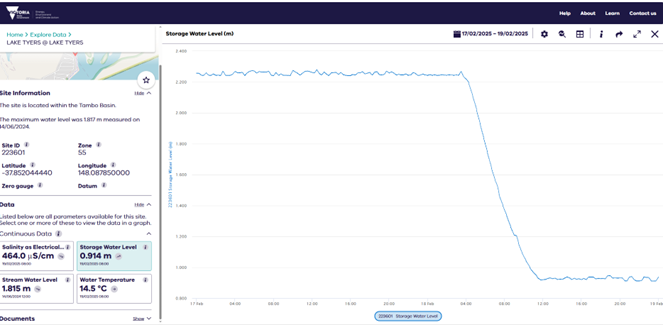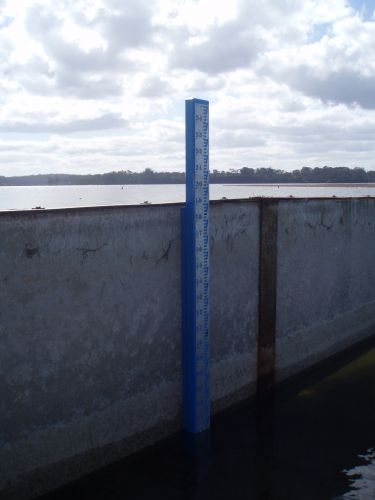Latest news
The Lake Tyers estuary is currently closed to the sea.
The Lake Tyers estuary extends from the sand barrier on the Ninety Mile Beach to Nowa Nowa. The entrance is subject to strong currents and wave action, and sand supply along the beach has frequently closed the entrance.
Lake Tyers Estuary Opening fact sheet can be found here.
The area of land subject to inundation when the estuary closes is small. The estuary has a comparatively small catchment, and high volumes of water are needed for an opening (artificial and natural) to be successful.
The East Gippsland CMA has been monitoring the quality of the water throughout the Lake to determine the level of risk to environmental values, in particular fish species. Due to low oxygen levels in the lake there is a potential risk of localised fish deaths. Low oxygen levels particularly in the lower parts of the water column, is a major risk to fish, as immediately after an opening the oxygenated surface water layer drains out to sea. That in turn leaves behind water that is low in oxygen in the deeper areas of the estuary or that has drained from the surrounding land. A lack of oxygen is the primary cause of fish deaths.
Rain and flow into the catchment are required to mix the oxygen throughout the water column and lessen the degree of stratification of salt and fresh water through the lake.
Stratification and Low Dissolved Oxygen
Stratification of water in an estuary can occur in certain conditions and is the separation of saltwater from freshwater. This is because the higher salt content of saltwater which makes it denser than freshwater. The difference in density means that when saltwater enters estuaries it flows in along the bottom and wedges underneath the freshwater. Stratification of the fresh and saltwater in an estuary often occurs during periods of low flow, particularly during summer and early autumn when there is little mixing between the two layers due to decreased freshwater inflows and a closed estuary mouth.
Closure of an estuary and little in or outflow can also result in deoxygenated water, particularly towards the bottom of the water column. Deoxygenated water is when more oxygen is being used up than can be replaced. Decomposition of organic matter uses oxygen in the water and increases when additional areas of vegetation are flooded, for extended periods (leaves and debris breaking down). When there is no oxygen present then decomposition becomes anaerobic, which means that it is done without oxygen.
This leads to the production of hydrogen sulphide, which is commonly known as rotten egg gas due to its smell. Oxygen can be replaced in water through photosynthesis of aquatic plants (plants growing); direct diffusion from the atmosphere (rain); turbulent aeration (wind / waves) and through tidal and freshwater inflows.
Pattern of closures
Between 1983 and 2011 the estuary was closed for 75% of the time, including one closure for over four years. Strong west and south westerly winds that generate storm waves at an oblique angle to the beach and transport large volumes of sand across the entrance appear to be the major factor influencing closures. There seems to be no pattern of closures directly related to rainfall (and resultant flows) possibly due to the size of the waterway compared to the size of the catchment.
Location of flooding
The steep topography adjoining the estuary means that the area of land subject to inundation when the estuary closes is comparatively small. Inundation occurs at boat ramps, jetties, camping areas and fishing platforms at Nowa Nowa during periods of extended closure. There may also be restricted access to boat ramps and walking tracks at Lake Tyers.
Level required for a successful opening
The water level in the estuary during an extended closure is about 1.7m (indicated by marks on infrastructure surrounding the estuary). The maximum water height, where the entrance either opens naturally or is opened manually, is approximately 2.3m (as indicated on the gauge at the boat ramp). This significant variation underlies that fact that the opening is associated with periods of high intensity rainfall and the corresponding inflows.
Water height levels are found on Victoria’s Water Measurement Information System | WMIS Site (WMIS). These measurements are taken from a gauge located at Lake Tyers. Other Data is collected including salinity, stream water level and water temperature.

The page from WMIS above shows the maximum height prior to opening on 18 February 2025 and then the decline in the water height following this.
Once open the estuary water level drops to close to sea level within 24 to 36 hours and creates a significant entrance through the sand-bar. The duration of the opening varies and depends on the inflows and prevalence of strong westerly winds.
Responsibility for an opening
A natural opening is the preferred outcome. However, if an artificial opening is to be made, this is authorised by East Gippsland CMA and operationalised by Parks Victoria.
Location of gauge
The gauge height board is attached to the concrete wall beside the boat ramp.



